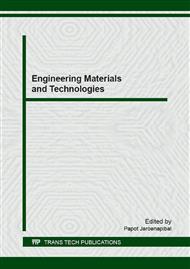p.77
p.81
p.87
p.95
p.100
p.105
p.110
p.115
p.120
RSM Optimization for the Production of Activated Carbons from Para-Wood Residue
Abstract:
Para-wood residue was impregnated in 40% wt. of H3PO4 solution for 24 h before carbonization under different temperatures and times. The response surface methodology (RSM) based on Box-Behnken was applied to optimize the operating conditions in producing activated carbon with high specific surface area. The effects of three variables; impregnation ratio, carbonising temperature and time on the specific surface of activated carbons were investigated. The proposed model was almost in accordance with the experimental case with correlation efficient and of 0.9653 and 0.9029, respectively. The optimal conditions were found to be 6%wt. of impregnation ratio and carbonization at 400°C for 67.27 min. The predicted surface area of produced activated carbon under these optimal conditions determined by RSM was 1069.30 m2/g. Experimental validation at these conditions was observed of 978.95 m2/g which closely agreed with the predicted value. This obtained activated carbon structure composed of mesopores and micropores with the average pore diameter of 21.71°A. This study indicated the RSM based on Box-Behnken design was the effectively method to optimize the operating condition and maximize the specific surface area of produced activated carbons.
Info:
Periodical:
Pages:
100-104
Citation:
Online since:
November 2016
Authors:
Keywords:
Price:
Сopyright:
© 2017 Trans Tech Publications Ltd. All Rights Reserved
Share:
Citation:


